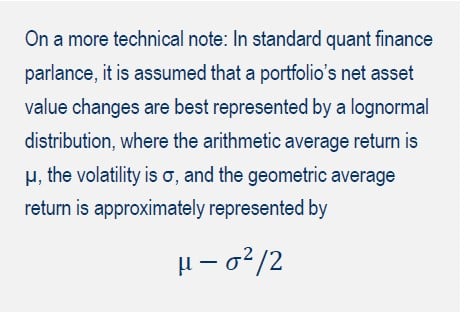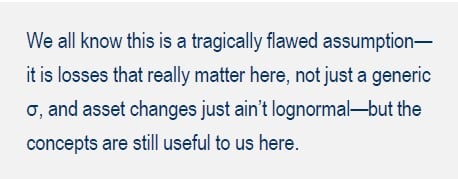There are few statements in the pantheon of investment management clichés that ring truer than these words of Benjamin Graham:
“The essence of investment management is the management of risks, not the management of returns. Well-managed portfolios start with this precept.”
This is the same basic message as my favorite cliché that “defense wins championships.” (I have annoyed my hockey-player son to no end with that one.) Indeed, we have built an entire investment business around this principle. One doesn’t prioritize risk management over long-term compound returns; the two priorities are very much one-in-the-same.
What we’ve learned in this Safe Haven Investing series so far is that the shape of the risk mitigation strategy’s payoff profile relative to systemic moves such as in the S&P 500 (SPX) is the most important determining feature of that strategy’s effectiveness at achieving that priority—more important even than, for instance, the average stand-alone return of that payoff. And the optimal shape has been a highly nonlinear, convex one. The counterintuitive nature of this is due to the similarly counterintuitive nature of what I call the “volatility tax”.
The volatility tax is the hidden tax on an investment portfolio caused by the negative compounding of large investment losses.
Much in the same way most tax changes take the form of a political sleight of hand (typically shifting taxes between one group and another), the volatility tax also comes down to stealth, mathematical trickery.
Here’s how this “tax” is levied: Steep portfolio losses (or “crashes”) crush the long-run compound annual growth rate (CAGR) of that portfolio. It just takes too long to recover from a much lower starting point. An extreme example is losing 50% one year and then making 100% the next, with an (arithmetic) average annual return over that two-year period of +25%. That’s pretty impressive, until you consider that you’re right back where you started by the end of those two years. The volatility tax transformed what looked like an impressive return into a not-so-impressive 0% compound (or geometric) return.
Put simply, the geometric average return of an asset is a function of the difference between its arithmetic average return and a measure of its volatility. As that volatility is reduced, the geometric average return is increased, as we are subtracting a lower volatility number. The greater the spread between the geometric and arithmetic average returns, the greater the volatility tax being levied. (It is 25% in the previous example.)
To put this in a historical context, in the past 20 years if you had owned only the SPX and had managed to avoid every annual loss worse than -15% (there were just two of them), your geometric average return would have gone from 7.2% to 11.08%, and your arithmetic average return would have gone from 8.81% to 11.77%. (The spread between the geometric and arithmetic averages thus closed by almost 1%—the volatility tax savings). Your cumulative 20-year return would have gone from 302% to 377% on volatility tax savings alone (keeping the arithmetic average return at 8.81%); you can see just how steep that 1% volatility tax was!
Note that the above level of volatility tax savings and outperformance approximates the performance of the 97% SPX + 3% insurance prototype portfolio from Part One, where annual SPX returns worse than -15% were essentially erased with a break-even stand-alone insurance payoff (so that the portfolio’s arithmetic average return was approximately unchanged).
Minimizing this negative compounding, or paying less volatility tax, results in higher sustained CAGRs and is the very name of the game in successful investing. It is the key to the kingdom, and explains in a nutshell Warren Buffett’s cardinal rule, “Don’t lose money.” Moreover, as the U.S. pension system can attest to directly, the large drawdowns, not the average returns, are what tend to dominate long-term portfolio value, and thus the system’s solvency over the long run.
It seems there should be something we can do to mitigate these high volatility taxes. (The entire hedge fund industry was essentially built around this very premise.) This would require a risk mitigation plan that can lower portfolio losses in a way that consequently raises long-run portfolio CAGRs. Unfortunately, the reality is that very little has been successful at accomplishing this lofty goal.
The investment industry’s dogma of diversification— owning a broad range of assets across stocks, bonds, hedge funds, etc., that hopefully won’t all drop together— has not been, as billed, “the only free lunch in finance.” Many assets see their correlations deviously spike in a crash, and thus they provide less of a loss cushion than is expected; and even when diversification has lowered portfolio losses, it typically has also lowered portfolio compound returns—all in the name of higher Sharpe ratios (which, with extreme irony, required investors to apply leverage to their portfolios in order to somehow make risk mitigation increase their returns).
The other solution of timing the market by avoiding risk during high valuation periods such as today has generally provided some long-term volatility tax savings (and higher compound returns) historically; but it is simply impossible to stomach this strategy in today’s buoyant and bubbly market. All too often, it results in the opposite strategy: buying high and selling low.
All is not lost. This is a call to action, to better understand what your exposures really are and think about the value proposition of risk mitigation or, when relying on diversification, the lack thereof. We can make progress just by being better aware of this hidden and destructive tax and the hefty costs it extracts from investment portfolios, especially in environments like the current one.
It all sounds a little fatalistic, but after all, nothing is so certain as death and taxes, which certainly includes the volatility tax.
Article By Mark Spitznagel
President & Chief Investment Officer
Universa Investments L.P.
Mark founded Universa Investments L.P. in January 2007 and has developed its unique focus on risk mitigation in the context of achieving long-term improvements to portfolio construction. His investment career has spanned over 20 years as a derivatives trader, during which he has cultivated his approach to safe haven strategies, specifically bespoke tail hedging. Mark received an M.S. in Mathematics from the Courant Institute of Mathematical Sciences at New York University and a B.A. from Kalamazoo College.
See the full PDF below.








